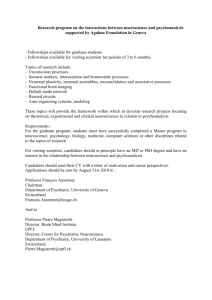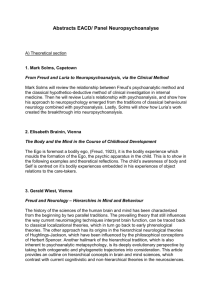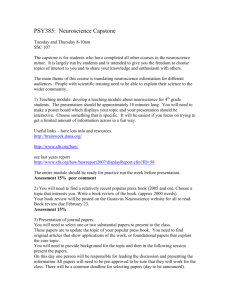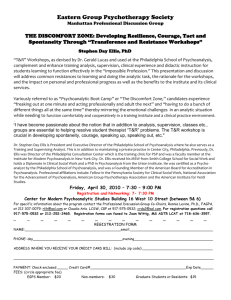1 NEUROSCIENCE AND PSYCHOANALYSIS Instructor: Joye
advertisement
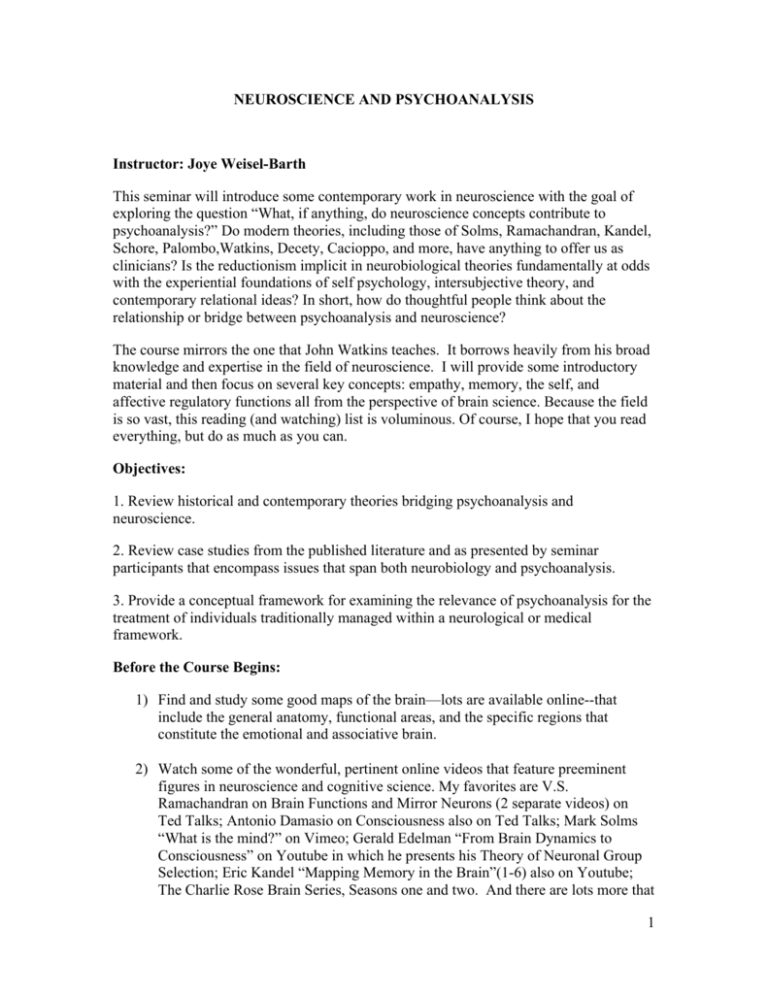
NEUROSCIENCE AND PSYCHOANALYSIS Instructor: Joye Weisel-Barth This seminar will introduce some contemporary work in neuroscience with the goal of exploring the question “What, if anything, do neuroscience concepts contribute to psychoanalysis?” Do modern theories, including those of Solms, Ramachandran, Kandel, Schore, Palombo,Watkins, Decety, Cacioppo, and more, have anything to offer us as clinicians? Is the reductionism implicit in neurobiological theories fundamentally at odds with the experiential foundations of self psychology, intersubjective theory, and contemporary relational ideas? In short, how do thoughtful people think about the relationship or bridge between psychoanalysis and neuroscience? The course mirrors the one that John Watkins teaches. It borrows heavily from his broad knowledge and expertise in the field of neuroscience. I will provide some introductory material and then focus on several key concepts: empathy, memory, the self, and affective regulatory functions all from the perspective of brain science. Because the field is so vast, this reading (and watching) list is voluminous. Of course, I hope that you read everything, but do as much as you can. Objectives: 1. Review historical and contemporary theories bridging psychoanalysis and neuroscience. 2. Review case studies from the published literature and as presented by seminar participants that encompass issues that span both neurobiology and psychoanalysis. 3. Provide a conceptual framework for examining the relevance of psychoanalysis for the treatment of individuals traditionally managed within a neurological or medical framework. Before the Course Begins: 1) Find and study some good maps of the brain—lots are available online--that include the general anatomy, functional areas, and the specific regions that constitute the emotional and associative brain. 2) Watch some of the wonderful, pertinent online videos that feature preeminent figures in neuroscience and cognitive science. My favorites are V.S. Ramachandran on Brain Functions and Mirror Neurons (2 separate videos) on Ted Talks; Antonio Damasio on Consciousness also on Ted Talks; Mark Solms “What is the mind?” on Vimeo; Gerald Edelman “From Brain Dynamics to Consciousness” on Youtube in which he presents his Theory of Neuronal Group Selection; Eric Kandel “Mapping Memory in the Brain”(1-6) also on Youtube; The Charlie Rose Brain Series, Seasons one and two. And there are lots more that 1 browsing will reveal (kiss your free time goodbye!). Week 1 Introduction: Strategies for Bridging Psychoanalysis and Neuroscience Kandel, E. R. (1999). Biology and the future of psychoanalysis: A new intellectual framework for psychiatry revisited. American Journal of Psychiatry, 156, 505-524. Schore, A. N. (1997). A century after Freud's Project: Is a rapprochement between psychoanalysis and neurobiology at hand? Journal of the American Psychoanalytic Association, 45(3), 807-840. Watkins, J. M. (in press). On Aphasia, the Danger Situation, and Contemporary Efforts to Link Psychoanalysis and Neuroscience Chapter 2: In Watkins, J. M. Psychoanalysis and the New Sciences of the Brain Solms, M. (2000) “Preliminaries for an Integration of Psychoanalysis and Neuroscience,” Ann. Psychoanal. 28: 179-200. Week 2: Introduction to Selected Neuroscience Concepts I: The neuron, neurotransmitters, neuronal networks, mirror neuron, and Theory of Mind Ramachandran, V.S. (2011). Introduction: “No mere ape” and Chapter 5: “Where is Steven? The riddle of autism.” In The tell-tale brain: A neuroscientist’s quest for that makes us human. New York: Norton. Iacoboni, M. (2008). Chapter 1. “Monkey see, monkey do.” Chapter 6. “Broken Mirrors.” In Mirroring People: The new science of how we connect with others. New York: Farrar Straus Giroux. Decety, J. and Lamm, C. (2006). Human empathy through the lens of social neuroscience. The Scientific World JOURNAL 6, 1146–1163. DOI 10.1100/tsw.2006.221. Gallese, V. (2003). The roots of empathy: The shared manifold hypothesis and the neural basis of intersubjectivity. Psychopathology, 36, 171-180. Week 3: Introduction to Selected Neuroscience Concepts II: MemoryMcNally, R.J. Chapter 6: Theories of repression and dissociation. In Remembering Trauma. Cambridge, MA: Belknap Press. Sroufe, L.A., et al. (2005). Clinical Implications, Chapter 13 In The Development of the Person, 265-286. New York: The Guilford Press. Squire, L.R., & Kandel, E.R. (2009). Chapter 8: Priming, Perceptual Learning, and nd Emotional Learning. In Memory: From mind to molecules (2 Ed.). Greenwood Village, 2 CO: Roberts. Week 4: Solms’ Neuropsychoanalysis: Freud’s Mind and Luria’s Brain Chapters 2, 9, 10. In Solms, M. & Turnbull, O. (2002). The brain and the inner world: An introduction to the neuroscience of subjective experience. New York: Other Press. Chapter 6: Psychoanalytic observations on a case of Wernicke’s aphasia: perforated consciousness. In Kaplan-Solms, K. & Solms, M. (2002). Clinical studies in neuropsychoanalysis. New York: Karnac. Solms, M. (2000). Freud, Luria and the clinical method. Psychoanalysis and History, 2, 76-109. Chapters 1, 2, 4. In Brothers, L. (2001). Mistaken identity: The mind-body problem reconsidered. New York: State University of New York Press. Atwood, G. E., & Stolorow, R. D. (1997). Defects in the self: Liberating concept or imprisoning metaphor? Psychoanalytic Dialogues, 7, 517-522. Week 5: Schore’s Regulation Theory Schore, A. N. (2003a). Chapter 6: The effects of a secure attachment relationship on right brain development, affect regulation, and infant mental health, Affect dysregulation and disorders of the self, New York: Norton Schore, A. N. (2003b). Chapter 3: Clinical implications of a psychoneurobiological model of projective identification; Chapter 8: The right brain as the neurobiological substratum of Freud’s dynamic unconscious. Affect regulation and the repair of the self, New York: Norton Schore, A. N. (2003b). Chapter 4: Advances in neuropsychoanalysis, attachment theory, and trauma research: Implications for self psychology, Affect regulation and the repair of the self. New York: Norton. Orange, D. (2003). Antidotes and alternatives: Perspectival realism and the new reductionisms. Psychoanalytic Psychology, 20, 472-486. Brothers, L. (2001). Mistaken identity: The mind-body problem reconsidered. Chapters, 3, 6. New York: State University of New York Press. Week 6: New Neuroscience Applications for Psychoanalysis-Development and Social NeuroscienceGerald Ele Palombo, J. (2006). Nonverbal learning disabilities: a clinical perspective, Chapter 12: Treatment, New York: W.W. Norton 3 Watkins, J. M. Chapter 7: Neurodevelopmental Psychoanalytic Approaches, Psychoanalysis and the New Sciences of the Brain. Cacioppo, J. T. (2002). Social neuroscience: Understanding the pieces fosters understanding of the whole and visa versa. American Psychologist, 57, 819-831. Cacioppo, J. T. & Patrick, W. (2008). Chapters 1 to 5. Loneliness: Human nature and the need for social connection. New York: W. W. Norton. Watkins, J.M. Chapter 8, New strategies for bridging psychoanalysis and neuroscience. .Psychoanalysis and the New Sciences of the Brain. 4
